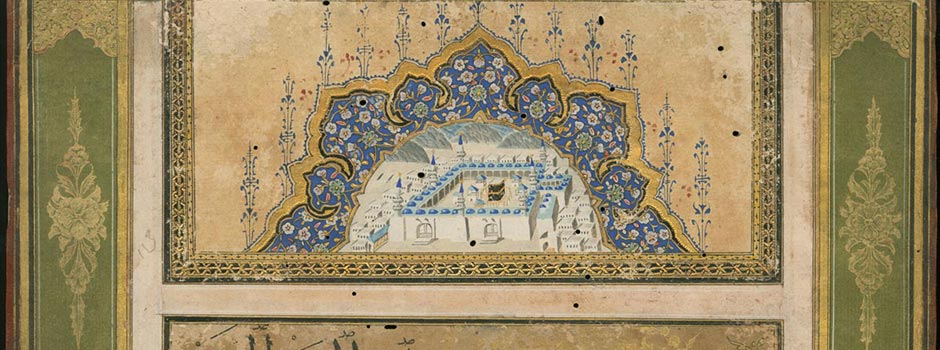
ART EXHIBITION ‘Pearls of Wisdom’ - The Arts of Islam at the University of Michigan
Dec 17, 2014 Art Collection

Curated by Christiane Gruber and Ashley Dimmig the exhibition showcases ceramics, glasswares, metalwares, woodwork, textiles, illustrated manuscripts, and paintings, held in the Kelsey Museum of Archaeology, the Special Collections of the Hatcher Graduate Library, the University of Michigan Museum of Anthropological Archaeology, and the University of Michigan Museum of Art.
'Pearls of Wisdom' is devided into themes: Everyday Beauty, Play and Protection, Media Metaphors and Illumination. In addition, the exhibition aims to showcase the richness and diversity of Islamic art through a range of artworks from the collections of the University of Michigan, Ann Arbor. The exhibition highlights how patrons, artists, and other individuals have used the expressive arts in order to promote social order and spiritual harmony. They also reveal how the visual arts help envision and implement a harmonious order of living in various Islamic cultures from the seventh century until the present day.
As the art of beautiful writing, calligraphy is not just a means to convey information. Contemporary artists have used the Arabic alphabet to produce paintings, calligraffiti, and abstract compositions. Such example is the painting by Syrian-born contemporary calligraphy artist Khaled al-Saa’i. 'Winter in Ann Arbor' is constructed as an ethereal composition by layering and juxtaposing Arabic letterforms in varying sizes. The painter transcends legibility and instead focuses on the form of the letters.
.jpg) Khaled al-Saa’i (born 1970), 'Winter in Ann Arbor', Painted in Ann Arbor in 2002, Natural ink, tempera, and gouache on paper, University of Michigan Museum of Art, 2003.1.366 / Courtesy of University of Michigan
Khaled al-Saa’i (born 1970), 'Winter in Ann Arbor', Painted in Ann Arbor in 2002, Natural ink, tempera, and gouache on paper, University of Michigan Museum of Art, 2003.1.366 / Courtesy of University of Michigan
The 17th-century Ottoman example of Illuminated double-page opening of the Qur’an is beautifully illuminated. In this manuscript a large portion of the page is covered in gold and further decorated with flowers and vegetal patterns painted in red, blue, and various pastels. Another beautiful example of calligraphy mastery is also a calligraphic treatise written in Ottoman Turkish. Kebecizade Mehmet Vasfi Efendi, a master calligrapher created an interesting composition presenting a system of proportions based on the rhomboid.
 Illuminated double-page opening of the Qur’an. Dated AH 1032/1623 CE, Ottoman lands, Ink and gold on paper, Special Collections, Hatcher Graduate Library, Isl. Ms. 167 / Courtesy of University of Michigan
Illuminated double-page opening of the Qur’an. Dated AH 1032/1623 CE, Ottoman lands, Ink and gold on paper, Special Collections, Hatcher Graduate Library, Isl. Ms. 167 / Courtesy of University of Michigan
_Penned-by-Kebecizade-Mehmet-Vasfi-Efendi-(d-1831).jpg) Calligraphy Treatise (Risale-yi hat), Penned by the calligrapher Kebecizade Mehmet Vasfi Efendi (d. 1831), Ottoman lands, ca. 1772, Ink on paper, Special Collections, Hatcher Graduate Library, Isl. Ms. 401 / Courtesy of University of Michigan
Calligraphy Treatise (Risale-yi hat), Penned by the calligrapher Kebecizade Mehmet Vasfi Efendi (d. 1831), Ottoman lands, ca. 1772, Ink on paper, Special Collections, Hatcher Graduate Library, Isl. Ms. 401 / Courtesy of University of Michigan
The highlight from the exhibition is also the Hilya by the famous Ottoman calligrapher Hafiz Osman (1642–1698), describing the Prophet's moral and physical attributes. The center panel consists of one large circle (göbek, or "navel" in Turkish) flanked by four small circles that frame the names of the first four caliphs. At the head of the triptych appears a delicately painted image of the Ka‘ba.
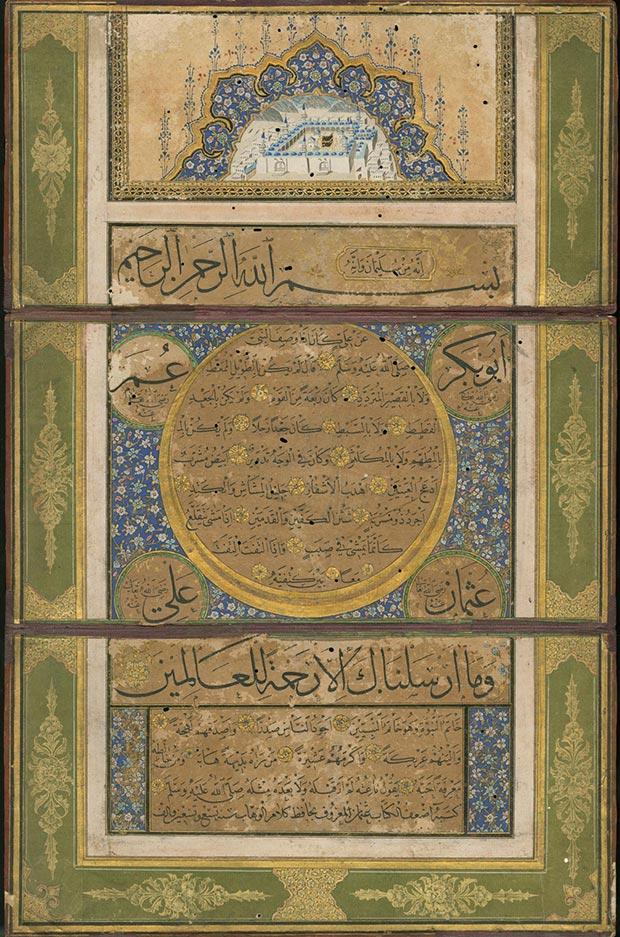 Hilye (verbal icon of the Prophet Muhammad), Calligraphy by Hafiz Osman, AH 1099/1687–1688 CE, Ottoman lands, Ink and pigment on paper mounted on three folding panels, Special Collections, Hatcher Graduate Library, Isl. Ms. 238 / Courtesy of University of Michigan
Hilye (verbal icon of the Prophet Muhammad), Calligraphy by Hafiz Osman, AH 1099/1687–1688 CE, Ottoman lands, Ink and pigment on paper mounted on three folding panels, Special Collections, Hatcher Graduate Library, Isl. Ms. 238 / Courtesy of University of Michigan
Calligraphy is not the only art form that fulfills both utilitarian and aesthetic functions. Many objects produced in various media illustrate the harmony between utility and beauty in the arts of the Islamic world. Some functional objects could be made visually appealing through decoration or strategically employ ornament for practical purposes. Such is the case with glass and ceramic water filters, which are patterned with an array of playful designs.
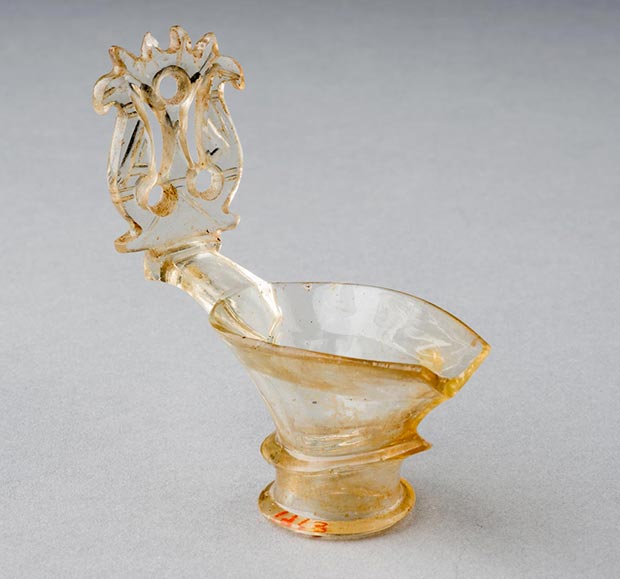 Pouring spout and ornate thumb rest, 10th–12th centuries, Egypt, Blown and cut glass. Kelsey Museum of Archaeology, 1970.3.60 / Courtesy of University of Michigan
Pouring spout and ornate thumb rest, 10th–12th centuries, Egypt, Blown and cut glass. Kelsey Museum of Archaeology, 1970.3.60 / Courtesy of University of Michigan
Mamluk pen box is another beautiful artwork from the exhibition, made of brass and inlaid with gold and silver, much of which is now lost. The case belonged to Sharaf al-Din, a Mamluk official (amir) active in Egypt during the mid-14th century. Ornately decorated and inlaid boxes such as this one functioned as tools and symbols of high office.
_14th-century_Egypt_Brass-inlaid-with-gold-and-silver_Kelsey-Museum-of-Archaeology_28802.jpg) Mamluk pen box (qalamdan), 14th century, Egypt, Brass inlaid with gold and silver, Kelsey Museum of Archaeology, 28802 / Courtesy of University of Michigan
Mamluk pen box (qalamdan), 14th century, Egypt, Brass inlaid with gold and silver, Kelsey Museum of Archaeology, 28802 / Courtesy of University of Michigan
While calligraphy has a special place in Islamic art, the pursuit of beauty bounds all works of art, from calligraphy and painting to ceramics, textiles and architecture. Such example is the Bowl with bird and inscription design, from 11th century, painted with luster that shimmers like gold. Among many exhibited textiles we can mention two; the textile fragment from Fatimid period in Egypt, a polychrome tapestry fragment, stitched to a plain linen ground and the tiraz (inscribed) fragment that stands out not only for its painted gold inscription but also for its complex patterning of color, which is achieved by resist-dyeing the warp threads prior to weaving the cloth. This technique, known as ikat, is characteristic of Central Asian textiles. This particular color palette and ikat pattern, however, were commonly used in tiraz textiles produced in medieval Yemen, after which imitations started to be produced in Egypt.
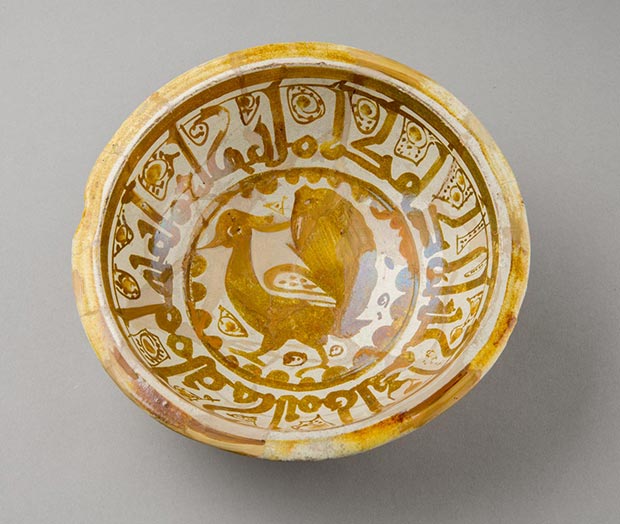 Bowl with bird and inscription design, 11th century, Iraq, Syria, or Egypt, Luster-painted ceramic. Kelsey Museum of Archaeology, 29964 / Courtesy of University of Michigan
Bowl with bird and inscription design, 11th century, Iraq, Syria, or Egypt, Luster-painted ceramic. Kelsey Museum of Archaeology, 29964 / Courtesy of University of Michigan
 Textile fragment with interlace design, 11th–12th centuries, Egypt, Linen and silk. Kelsey Museum of Archaeology, 91614 / Courtesy of University of Michigan
Textile fragment with interlace design, 11th–12th centuries, Egypt, Linen and silk. Kelsey Museum of Archaeology, 91614 / Courtesy of University of Michigan
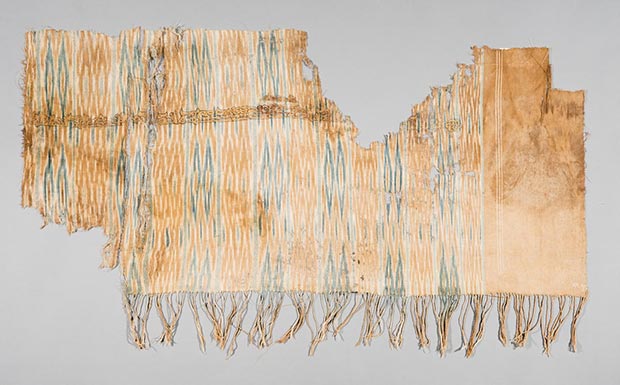 Tiraz textile, Yemen or Egypt, 10th–12th centuries, Cotton with resist-dyed warp (ikat), ink, and gold paint, Kelsey Museum of Archaeology, 22621 / Courtesy of University of Michigan
Tiraz textile, Yemen or Egypt, 10th–12th centuries, Cotton with resist-dyed warp (ikat), ink, and gold paint, Kelsey Museum of Archaeology, 22621 / Courtesy of University of Michigan
More information on the exhibition here.
Comments
Add a comment